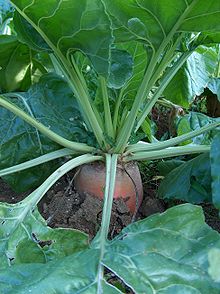Mangelwurzel
| Mangelwurzel | |
|---|---|

Mangelwurzel
|
|
| Species | Beta vulgaris |
| Subspecies | Beta vulgaris subsp. vulgaris |
| Cultivar group | Crassa Group |
| Origin | Sea beet (Beta vulgaris subsp. maritima) |
Mangelwurzel or mangold wurzel (from Mangel/Mangold and Wurzel, "root"), also called mangold,mangel beet,field beet, and fodder beet, is a cultivated root vegetable. It is a variety of Beta vulgaris, the same species that also contains the red beet and sugar beet varieties. The cultivar group is named Crassa Group. Their large white, yellow or orange-yellow swollen roots were developed in the 18th century as a fodder crop for feeding .
Contemporary use is primarily for cattle, pig and other stock feed, although it can be eaten – especially when young – by humans. Considered a crop for cool-temperate climates, the mangelwurzel sown in autumn can be grown as a winter crop in warm-temperate to sub-tropical climates. Both leaves and roots may be eaten. Leaves can be lightly steamed for salads or lightly boiled as a vegetable if treated like English spinach. Grown in well-dug, well-composted soil and watered regularly, the roots become tender, juicy and flavourful. The roots are prepared boiled like potato for serving mashed, diced or in sweet curries. Animals are known to thrive upon this plant; both its leaves and roots provide a nutritious food. George Henderson, a 20th-century English farmer and author on agriculture, stated that mangel beets were one of the best fodders for dairying, as milk production is maximized.
The mangelwurzel has a history in England of being used for sport, for celebration, for animal fodder and for the brewing of a potent alcoholic beverage. The 1830 Scottish cookbook The Practice of Cookery includes a recipe for a beer made with mangelwurzel. In 19th-century American usage, mangel beets were sometimes referred to as 'mango.'
During the Irish Famine (1845–1852), Poor Law Guardians in Galway City leased (on a 999-year-lease) a twenty-acre former nunnery to house one thousand orphaned or deserted boys ages from five to approximately fifteen. Here the boys were taught tailoring, shoe making, and agricultural skills. On a five-acre plot, they grew potatoes, cabbage, parsnips, carrots, onions, Swedish turnips, and "mangold wurtzel"--both for workhouse consumption as well as for a cash crop. See Lord Sydney Godolphin Osbourne's "Gleanings in the West of Ireland" published in London 1850, T & W Boone, page 58.
...
Wikipedia
